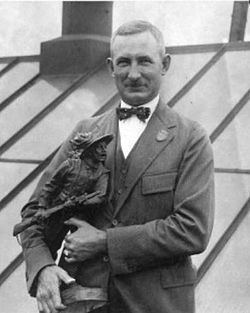Sport Sports shooting Role Olympic athlete | Name Carl Osburn Height 1.8 m | |
 | ||
Olympic medals Shooting at the 1920 Summer Olympics – Men's 100 metre team running deer, single shots Similar People Willis Augustus Lee, Morris Fisher, Vilhelm Carlberg, Niels Larsen | ||
Carl Townsend Osburn (May 5, 1884 – December 28, 1966) was an United States Navy officer and sports shooter from Jacksontown, Ohio. After graduating from the United States Naval Academy in 1906, Osburn went on to reach the rank of commander. He competed in the 1912 Summer Olympics, 1920 Summer Olympics, and 1924 Summer Olympics, winning a total of eleven Olympic medals: five gold medals (including two individual gold medals), four silver medals, and two bronze medals. He is the most successful shooter at the Olympic Games when individual and team medals are both taken into the account. His tally of eleven medals made him the all-time leading male medal winner for the United States at the Olympic Games. In 1972, Mark Spitz tied this record after having won four medals in 1968 and seven in 1972. Michael Phelps has since broken this record.
Contents
Military history
Osburn was admitted to the U.S. Naval Academy as a midshipman on August 1, 1903, graduating in 1906, earlier than scheduled, to address a shortage of naval officers. He was assigned for his sea service as a midshipman on board USS Rhode Island (BB-17) from October 12, 1906 to June 1908. He was then assigned to USS Castine, a gunboat serving as a submarine tender, from October 4, 1908 to May 1909, seeing service along the Atlantic coast. During operations off Cuba in 1908, he earned the right to wear the Cuban Pacification Medal. Osburn was commissioned an Ensign on February 12, 1909. Additionally, in 1909. Continuing his sea duty, Osburn was assigned on October 2, 1909, to USS Mississippi (BB-23), seeing service off the coast of New England until January 1910. Promoted to Lieutenant (j. g.) on February 12, 1912, Osburn was detailed in April from Mississippi to participate from June to July in the 1912 Olympic Games in Stockholm, Sweden, where he competed in rifle marksmanship. Osburn then embarked on another tour of duty at sea, this time in USS Des Moines (C-15), a cruiser, beginning on September 12, 1912, and lasting until June 1913. From September 22, 1913, until April 1915, Osburn saw shore duty at the U.S. Naval Academy, and then on May 13, 1915, returned to sea duty on board the presidential yacht USS Mayflower (PY-1), being promoted to Lieutenant on July 29, 1915. He received promotion to the permanent rank of Lieutenant Commander on July 1, 1919. Osburn took command of USS Schenck (DD-159), a recently commissioned vessel of wartime construction, and conducted patrols in the Caribbean until September 1921, when he was assigned to USS Relief (AH-1). On December 18, 1922, Osburn was assigned as the Naval Inspector of Ordnance at the Bausch & Lomb Optical Company in Rochester, New York, remaining there until March 1925. On April 14, 1925, Osburn took command of the newly re-commissioned USS Dallas (DD-199), which lasted until June 1927. Returning to shore duty on January 20, 1932, with the Bureau of Navigation, Osburn received his promotion to Captain on October 1, 1933. He then returned to sea on July 27, 1934, in command of USS Henderson (AP-1), a billet which he held until June 1936. On June 30, 1936, Osburn returned to shore duty with the 12th Naval District in San Francisco. In 1937 he was made the Director, Naval Reserves, for the 12th Naval District.
Personal history
Osburn retired with the rank of Captain in 1939 but was recalled to active duty in 1941 to serve as the War Plans Officer of the 12th Naval District, San Francisco until 1945. He then settled with his wife, Mary, in the Napa Valley, at St. Helena, California, where he died on December 28, 1966.
Osburn’s collection of medals, trophies and memorabilia were donated to the Naval Historical Foundation in 1967 by his widow, Mary Osburn. These artifacts are now in the custody of the Naval History and Heritage Command’s Curatorial Management Branch.
Osburn was inducted into the USA Shooting Hall of Fame in 1994 where he is listed as being one of the country's nine greatest marksmen.
